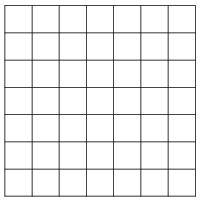Buffon's Needle Problem Revisited 2
Suppose you drop a needle onto a square grid. The center of the needle is going to land inside a grid square (the center lands on the boundary of a square with zero probability, so we can ignore this). What is the probability that the needle lies across the left, right, or bottom edges of this grid square ? (Find a closed form for this probability.)
Details and Assumptions:
(0) The grid is infinite in the x- and y- directions:

Source: grid image
(1) The length of the needle equals the length of each grid square.
(2) The center of the needle lands anywhere on the grid with equal probability.
(3) The needle can be rotated (around its center) at any angle with equal probability.
(i.e., the position and rotation of the needle are each distributed uniformly, as in Buffon's needle problem)
Inspired by Buffon's needle problem ..
Also see this problem
The answer is 0.796.
This section requires Javascript.
You are seeing this because something didn't load right. We suggest you, (a) try
refreshing the page, (b) enabling javascript if it is disabled on your browser and,
finally, (c)
loading the
non-javascript version of this page
. We're sorry about the hassle.
In the analysis of Buffon's Needle Problem (which I gave elsewhere), we find that
there is a probability of 2 / π that the needle crosses a horizontal line;
there is a probability of 2 / π that the needle crosses a vertical line;
there is a probability of 1 / π that the needle crosses both.
Now P ( needle crosses left, right, or down ) = 2 1 P ( needle lies in upper half of square and crosses a horizontal ) + 2 1 P ( needle lies in lower half of square and crosses any grid line ) = 2 1 ⋅ π 2 + 2 1 ( π 2 + π 2 − π 1 ) = 2 1 ⋅ π 2 + 2 1 ⋅ π 3 = 2 π 5 ≈ 0 . 7 9 6 .